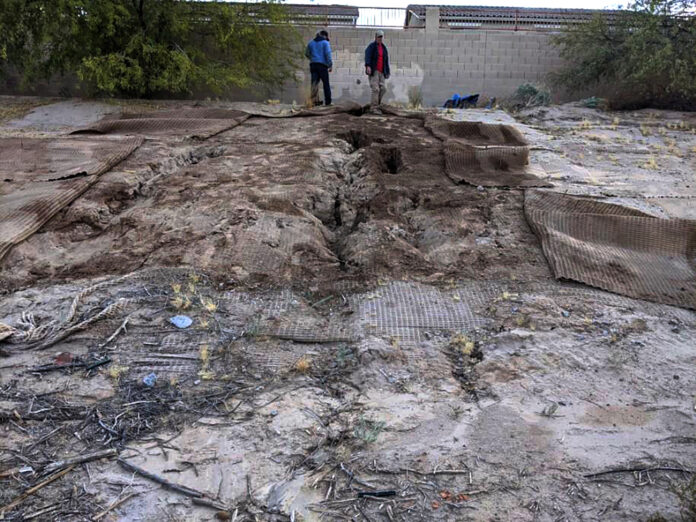
The Maricopa Flood Control District is working with City officials to prevent erosion in the city washes caused by residents.
An ordinance banning the release of water — pool backwashing, specifically — onto the banks of the washes is proposed. As more and more residents drain their pools into the wash, the district is having to foot the repair bill.
RELATED: Flood Control District moves fast on Santa Rosa Wash repairs
“This has become a significant problem which is costing the District a lot of money to repair,” said David Alley, the District’s executive director.
At a recent District meeting, Councilmember Bob Marsh indicated he would work with Alley on the ordinance. Alley showed photos of a recent repair behind a home in Senita, where a resident had rigged his pool equipment to backwash onto the upper bank of the wash, using rock in an attempt to defer erosion damage.
“The result was a 7-foot trench down the bank of the Santa Rosa,” Alley said.
The District’s contractor spent two days on the $5,000-plus repair, using several pieces of heavy equipment, Alley said. MFCD will have to bring material from south of the Maricopa-Casa Grande Highway to compact it enough to make it hold on the bank, as the soil at the site is loose.
Maintenance of the washes is the responsibility of the District, which is a special taxing district with its own budget, according to City Manager Rick Horst. He said his team is assisting the District.
Alley said that while it may seem like an overreaction to pass a law for a few people backwashing their pools into the wash, the issue is serious.
“People think that (the cost of repairing the damaged banks) is exaggerated, but it isn’t,” he said. “They think we just dig up some dirt, fill the hole and call it good. But the material has to contain enough clay and moisture to compact it firmly or it will not hold.”
Alley said that while the City may be in charge of enforcement, local homeowners associations may also get involved.
“I’m sure the Council will accept their input,” he said. “It is unlikely they will be charged with enforcement. And any penalties (from the HOA) may require a change of the (Covenants, Conditions and Restrictions), which I presume would require a vote of the membership.”
City council will decide what, if any, penalties to assess violators of a new ordinance, but Alley said he will have a say in the matter.
“My input will be to make the fines escalate for multiple offenses and start higher if the offense involves a high quantity of water, such as emptying a pool or spa,” he said.
The Senita resident was somewhat of an outlier due to the sophisticated nature of his drainage scheme, but another resident had rigged PVC piping to shoot pool water over his back wall into the wash, Alley told the board at a recent meeting. But most residents are just looking for a convenient place to drain their water, he said, adding that however it is done, the costs add up.
“Not everyone goes to the trouble of installing a pipe,” he said. “Some probably just drop the hose over the wall. Our guess is we have repaired four different areas, at a total cost of approximately $30,000 over the last two years.”
The Maricopa FCD, which maintains miles of channels, is a special taxing district with an elected board. It spends tax dollars paid by district residents to repair damage and clear vegetation that could prevent the flow of floodwaters. It encourages residents to report abuses to keep taxes low.
Alley said those funds could be used for other flood control projects, including mowing the channels twice a year and hauling off dumped trash. The District also maintains an emergency fund to address damage from major flooding.


![Elena Trails releases home renderings An image of one of 56 elevation renderings submitted to Maricopa's planning department for the Elena Trails subdivison. The developer plans to construct 14 different floor plans, with four elevation styles per plan. [City of Maricopa]](https://www.inmaricopa.com/wp-content/uploads/2024/04/city-041724-elena-trails-rendering-218x150.jpg)

![Affordable apartments planned near ‘Restaurant Row’ A blue square highlights the area of the proposed affordable housing development and "Restaurant Row" sitting south of city hall and the Maricopa Police Department. Preliminary architectural drawings were not yet available. [City of Maricopa]](https://www.inmaricopa.com/wp-content/uploads/2024/04/041724-affordable-housing-project-restaurant-row-218x150.jpg)










![Elena Trails releases home renderings An image of one of 56 elevation renderings submitted to Maricopa's planning department for the Elena Trails subdivison. The developer plans to construct 14 different floor plans, with four elevation styles per plan. [City of Maricopa]](https://www.inmaricopa.com/wp-content/uploads/2024/04/city-041724-elena-trails-rendering-100x70.jpg)

![Affordable apartments planned near ‘Restaurant Row’ A blue square highlights the area of the proposed affordable housing development and "Restaurant Row" sitting south of city hall and the Maricopa Police Department. Preliminary architectural drawings were not yet available. [City of Maricopa]](https://www.inmaricopa.com/wp-content/uploads/2024/04/041724-affordable-housing-project-restaurant-row-100x70.jpg)